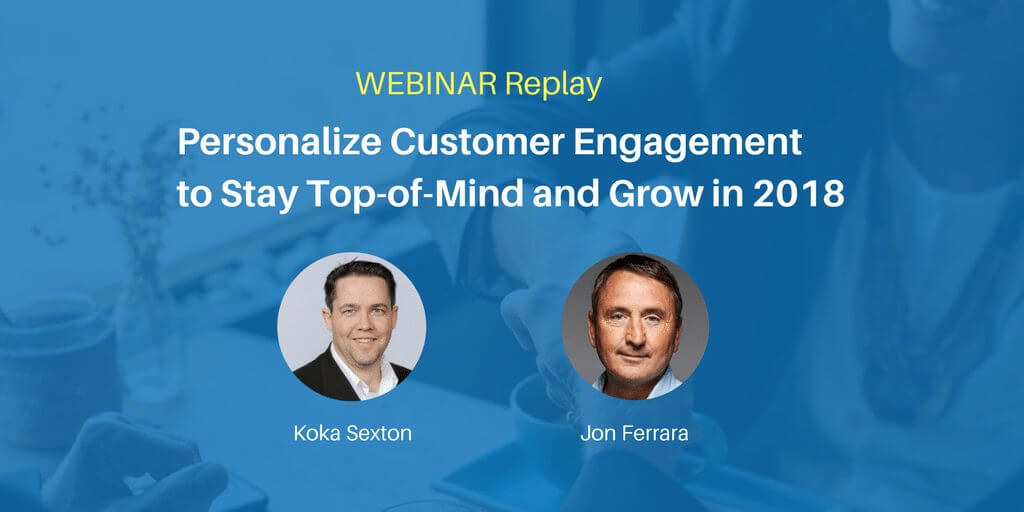If you weren’t able to make our recent webinar with Koka Sexton, we’ve got you covered. Koka and Nimble CEO Jon Ferrara first met at Sales 2.0 conference in San Francisco in 2012, while Jon giving a keynote about social selling.
They had a conversation, and both understood that people grow by helping others grow, and social media was a new means of listening and engaging to accomplish just that.
Koka believes that social selling methodologies stem from the idea or belief that you have to add value in excess of whatever you’re asking for in return.
Jon believes that there are few people as effective as Koka when it comes to building programs to build a brand, grow networks, and drive results. Let’s hit the ground running and learn how to achieve our goals in 2018!
Content + Engagement = Visibility & Opportunities
How do you build a brand? How do you attract people and get them to drag their friends with them?
“You have to add value in excess of what you’re asking for in return. The best way to add value is to educate and inform people on best practices and solve bigger problems.” ~ Koka Sexton
The mantra Koka believes and has wholeheartedly helped him is the idea of creating omnipresence. Omnipresence is the concept of being everywhere at all times. One of the biggest challenges is being a solo entrepreneur and creating enough visibility for yourself to have opportunities coming your way.
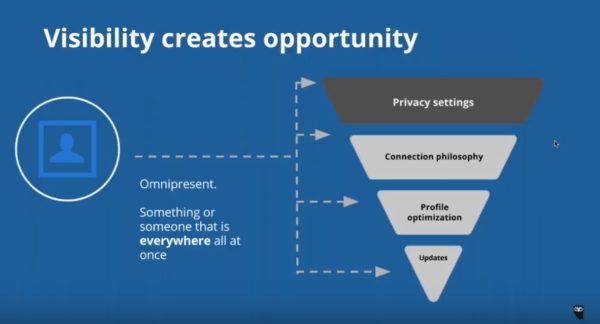
1.) First, you must open your social accounts—that is, adjusting your profiles to be on public rather than private settings.
2.) What’s your connection philosophy? Koka shares that his philosophy is, if you can add value to me, or I can add value to you, then I’ll connect with you. Not necessarily that this person must give you something immediately, but just that this person and yourself are able to learn from each other. This relationship can exist across professional fields or within them.
3.) Next is the idea of profile optimization. This is not SEO, though that’s important, it’s really a question of, are you developing your social profile to create visibility and show that you are customer-centric? As a salesperson, this is incredibly important. Make sure your profile shows the way you leverage your social networks in a way that shows you’re adding value and actually solving problems.
4.) Once you’ve gotten past these steps, you must start sharing. Sharing is ultimately what creates the visibility, so you have to share extremely relevant content. Another important thing to note is that relationships are crucial, and relationships are developed through engagement, so if you want people to engage, you must identify trigger events to go after in order to intrigue people.
While thinking about all of these aspects of social selling, don’t forget the consumer decision journey model—which explains how a consumer will initially decide to buy from you and eventually become wrapped up in a loyalty cycle. Essentially, as a business person, you must be able to walk in your customers’ digital journey and add value to the conversation throughout to become their trusted adviser.
So, when they think about your products and services they pick up the phone and call you and drag your friends with them, as well.
Be sure to always engage in authentic and human ways through the social journey. This eventually turns into the way you are gaining influence. Another key thing to understand is that in order to have influence you must starting having strong opinions and sharing them.
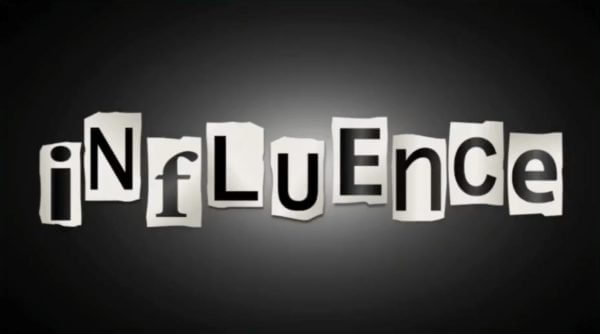
The results driven from connecting and engaging with people are not immediately seen and can take lots of time. Just be patient, and work at it until you begin achieving the things you hope for.
Overall, remember that visibility creates opportunity. It accelerates career growth, skill set, individual ideas, and influence. These days, if you don’t have an online presence (aka, you don’t exist online) you will likely not be considered for a job. Remember, influence matters. Your professional brand matters, so much more than it did 10 years ago.
Jack Kosakowski and Vala Afshar are two amazing examples of people that began to use social to build their brand to get ahead in their careers. After some time Vala worked his way to the top and became the Chief Digital Evangelist at Salesforce. Jack now serves as the US CEO of Creation Agency.
Detriments to Success on Your Social Selling Path
When it comes to influence, there are many good ways to go about it that have already been touched on. But it’s important to note some bad practices of influence, as well.
First, you should understand that these social channels are not sales channels—they are pre-sales. These are engagement platforms. Something bad I come across all the time, Koka explains, is connecting with someone on a social network, and being immediately hounded with sales pitches.
“There’s no relationship building at all,” he says. “If they go right in for the sales pitch, that makes me make one or two decisions. Either one, call them out on it, or just to disconnect from them.” There’s no way to effectively communicate using copy-and-paste messages like these. We must act human when we engage, not robotic.
Evolve Online Conversations into Offline Trusted Relationships
Here, Jon explained his belief that in order to be successful as a business person you need to get out of your building and out into the river.
Further, in order to grow your business, you need to get out into the social river and participate in conversations with customers. But once you build your brand and network, you need to convert those conversations into real-world trusted relationships.
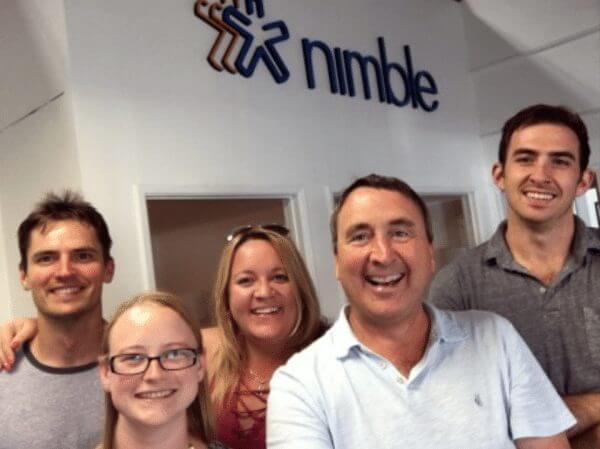
The photo above represents the real-world relationships that exist amongst the Nimble team. In this photo (from left) you can see Nimble’s Senior Project Manager Dmitri Krupnov, Customer Care Ninja Krystan Roselius, Heather Dopson, the Community Builder for GoDaddy who recently visited Nimble HQ, Nimble CEO Jon Ferrara and Product Marketing Manager Joey Kelly.
A great example of the development of an online relationship comes from Jon’s experience with Theo Rand from Disney. One of the great things about Nimble is that it will tell you when people are talking about you on social media.
So, as Jon was engaging and using Twitter one day, Nimble told him that a man named Theo was talking about him. Now, Jon didn’t know who he was but clicked this notification anyway. He saw that Salesforce’s Tiffany Bova tweeted that CRM isn’t about command and control but instead it’s about empowering customer-facing team members to provide a better experience. Theo responded, saying that this is what Jon at Nimble has been saying, and Jon was intrigued by his commentary and wanted to turn Theo into a connection.
So, Jon “Nimbled” him and found his contact information and turned their social media connection into a conversation, which eventually began an offline relationship. They grabbed a meal together and discussed the ways in which Nimble could add value in the places that Salesforce lacked in terms of working with the licensing department at Disney. Theo Rand is now an advocate for Nimble. He participates in the Nimble journey by providing support, as a friend.
Jon believes that it’s necessary to connect with people on the commonalities of life. These are:
1.) Family
2.) Friends
3.) Food
4.) Fun
5.) Fellowship
These are essential to making relationships last. After all, you’re not going to stay connected with someone based on the fact that you both sell CRM for example, you’ll stay connected because you both love to barbecue, or you love dogs.
Another example is Todd Nelmes. Todd and Jon connect on a level where they engage with each other’s content on Instagram, where they can bond over their love of photography. They’ve found a point of commonality that goes beyond just business and both benefit from it in the long run.
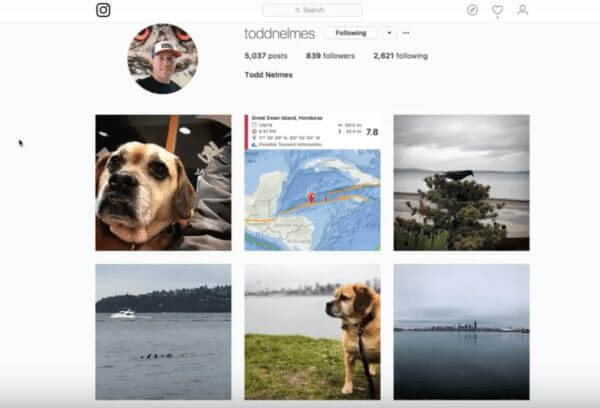
Keep in mind that relationships are scattered and can be messy. They often start in one place and shift to another and it’s important for you to be keeping up while working across various channels and eventually moving the relationships offline.
The Basics: Follow-up & Follow-through Drive Results
Jon explains that the biggest causes of failure in CRM systems are the lack of use and bad data. After all, “you have to work for your CRM. It doesn’t work for you,” he says.
Usually, the way a CRM works, one has to go and Google someone as soon as they learn of their existence, and go back to the CRM and manually plug in all their information. What Nimble does is build this record for you without doing extra work. It automatically searches the internet for information about the name you’re hovering over and helps you to begin your outreach process more smoothly. After this, you’re able to connect and schedule a follow-up and log notes of things that have been done or need to be done to enhance this relationship.
Another thing we can do is assign the task of connecting with this person to another team member within the Nimble platform. Now that we’ve delegated this task to them, it’s now connected to the person’s profile. Once they finished the task or commented on the assignment, we are notified.
The basics of general sales are important. You should constantly be trying to find easier and more efficient ways to capture, collect, and engage with these decision-makers. These are very valuable skills that are not taught nearly enough.
Prospecting Smarter to Build Connections that Matter
Jon explains his experience when he was invited to do a social selling talk at Inspire, the Microsoft Partner Conference. What he wanted to do was prepare before he went to reach out to people at the conference, so he found Twitter lists of the attendees.
There were about 3,500 people on this list of influencers and attendees from last year’s conference, so Jon used Nimble to store their contact information and segment them by areas of interest. Nimble automatically enriches people with areas of influence.
After this, Jon sent them one-to-one emails which had a 50% open rate! This occurred because he was relevant, authentic and one-to-one, which drove incredible results. He scheduled 25 meetings and signed a deal with Microsoft to become a global reseller of Nimble–Microsoft now resells Nimble combined with office 365.

This is a testament to the importance of sending personalized messages at scale, as well as being able to segment your outreaches based on interest. For example, I could segment by people who are interested in social media.
Did You Enjoy the Webinar? Let us Know What Topics We Should Cover Next!
We thank Koka for the opportunity to share with us his vast knowledge on social selling and hope to have him back soon. If you have any specific topics that you would like us to cover in any of our future webinars, let us know in the comments below or email us at [email protected] You can follow Koka on Twitter here and Jon on Twitter here.
